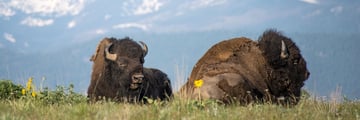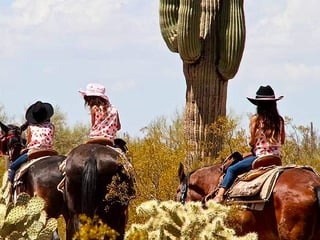Top 10 destinations for wildlife spotting in America
Read time: 8 mins
Given its huge variety of landscapes, it comes as no surprise that America is home to an incredible richness of wildlife - most of which has found refuge in its protected national parks. We’ve travelled coast to coast to stake out the nation’s best places for getting up-close with interesting beasts big and small (or at least marvelling at them from afar).

#10
Acadia National Park, Maine
The setting: The roll call of wildlife is huge at this Maine-coast archipelago covering 47,000 of easily accessible land on Mount Desert Island, Isle au Haut, and the Schoodic Peninsula (it’s the only national park in all of New England). Head here for a combo of towering forests, wildflower-carpeted meadows and marshes, rugged shores, sheltered coves, 125 miles of hiking trails, and 45 miles of rustic carriage roads famously gifted by philanthropist John D. Rockefeller Jr.
The wildlife: You can expect serendipitous sightings of countless species of animals, ranging from black bears and white-tailed deer, to coyotes, raccoons, skunks, otters, foxes, deer, and occasional moose. There’s also 338 bird species, including the predatory peregrine falcons, bald eagles, kestrels, hawks, herons, and some 23 recorded species of warbler. Equally worthy of your attention are the seals, dolphins and whales in the waters off the coast of Mount Desert Island, and the salamanders, frogs, and toads in the park’s spruce and pine forests.
Top viewing tips: Ranger-led bird walks take place between late spring and mid-autumn. It’s also worth heading to the Precipice and Valley Cove Cliffs to spot peregrine falcons - a mainstay in the park since 1991 when the first nesting was documented. If you’re here between August and mid-October, you’re likely to see American kestrels and broad-winged hawks.

#9
Wind Cave National Park, South Dakota
The setting: Over 142 miles of passageways have been mapped at the world’s sixth-longest cave system located near Hot Springs, just an hour from Deadwood. What this place lacks in stalactites and stalagmites, it makes up for with a subterranean maze filled with intricate boxwork (honeycomb-like calcite formations), the ponderosa pine forests of South Dakota's Black Hills, and the mixed-grass prairie of the western Great Plains that’s chock-full with highly-visible wildlife.
The wildlife: Animal sightings are never guaranteed, but given patience and perseverance you may enjoy at least one encounter with a bison, coyote, mountain lion, desert cottontail, big-eared bat, elk, mule deer, or black-tailed prairie dog - all of whom are wild, unpredictable, and should never be approached or fed. There’s also ample birdlife (mallard, sharp-tailed grouse, chickadee, kingbird, dove, falcon, hawk, black-backed woodpecker, western tanager) as well as a fair few rattlesnakes, bullsnakes, and nearly-harmless garter snakes crawling through tall grass.
Top viewing tips: The open prairie near the south entrance to the park headquarters is the best place to see pronghorn antelopes - the second-fasted land mammals in the world after cheetahs. Also, due to the park's small size, it’s unlikely that hikers and walkers will leave without seeing prairie falcons and meadowlarks in the grasslands and wild turkeys in the forests.

#8
Olympic National Park, Washington
The setting: Blessed with three unique ecosystems, wilderness areas don’t get more diverse than this spellbinding 900,000-acre park established by Theodore Roosevelt in a bid to preserve the breeding grounds of the elk that bore his name. Not only will you find temperate rainforests, glacier-topped mountains, and a 57-mile-long stretch of Pacific coast in Olympic National Park, Washington, but there’s also eleven major rivers offering some of the country’s best habitat for anadromous fish species.
The wildlife: In addition to the number of sanctuaries that exist for the Roosevelt elk, Columbia black-tailed deer, cougars, snowshoe hares, mountain goats, and Olympic marmots, there’s 300 species of birds, including bald eagles, northern pygmy owls, and sooty grouse. While all the park's wildlife are intriguing, most delightful are the black bears (not grizzlies) roaming far and wide in search of ripe berries and spawning salmon, and the offshore marine life that includes seals, sea otters, sea lions, and migrating gray whales (typically between March and May).
Top viewing tips: Head to Olympic's lower valleys and rainforests at dusk or dawn for Roosevelt elk sightings - or try the typically snow-covered Hurricane Ridge to see Columbia black-tailed deer. Keen anglers should make their way to the Salmon Cascades Overlook in the Sol Duc Valley from late-September to early-October to view the salmon's dramatic upstream journey.

#7
Great Smoky Mountains National Park, Tennessee & North Carolina
The setting: It’s all about the black bears at this half-million-acre park that straddles the border between Tennessee and North Carolina through the rolling green mountains of Southern Appalachia. As the largest protected black bear habitat in the eastern USA (there’s some 1,500 furry residents; roughly two bears per square mile), Great Smoky Mountains is the most-visited site in the national park system by a long shot - attracting more than ten million wide-eyed visitors every year.
The wildlife: As one of the most diverse ecosystems on earth, the park protects 66 species of mammals including elk, white-tailed deer, black bear, 200 varieties of birds, 50 species of native fish, and more than 80 types of reptiles and amphibians (there’s 30 different varieties of salamander). You can also rely on seeing hundreds and thousands of synchronous fireflies, a decent amount of bobcats, skunks, and wild boars, and any one of the 25 red wolves who live in the park and roam freely (they are one of the most endangered animals in the Smokies).
Top viewing tips: The beautiful Cataloochee Valley is the best place to spot elk, preferably just before sunset. To watch the phenomenon of photinus carolinus (the species of firefly that flashes synchronously), the annual Synchronous Firefly Event that takes place in late May or early June near the popular Elkmont Campground (the park runs a special lottery system for tickets).

#6
Maui, Hawaii
The setting: Easily the shining star of the Hawaiian Islands (the archipelago of eight major islands, several atolls, and numerous smaller islets in the North Pacific Ocean), Maui manages to pack idyllic beaches, green valleys, and volcanic landscapes into its 727 square miles. And the Aloha State is as remarkable when it comes to wildlife; not least for its vast number of endemic species that have evolved here over millions of years.
The wildlife: There’s only two land mammals native to Maui: the Hoary Bat and the Hawaiian Monk Seal. The Polynesians (and later Western explorers) introduced everything else, including the cow, goat, pig, rat, cat, goat, mongoose, and wild boar - many of which are seen as ecological nuisances. What’s far more interesting to nature-lovers are the humpback whales, dolphins (spinner, spotted, bottle), and 60 species of bird. Equally thrilling are the 300 pound Hawaiian green sea turtles who inexplicably bask on the sand at Ho‘okipa Beach Park at sunset.
Top viewing tips: The channel that runs between Maui and Molokai is one of the best spots for humpback whales during the winter months (if visiting between January and March, head to the Papawai Scenic Lookout just north of Ma‘alaea). Also visit the East Maui Animal Refuge in Haiku (also known as The Boo Boo Zoo) for close-ups with rehabilitated axis deer and owls.

#5
Grand Teton National Park, Wyoming
The setting: Teeming with wildlife, this 310,000-acre park located south of Yellowstone National Park and north of Jackson is part of one of the last remaining temperate ecosystems on the planet. Drawing large numbers of wildlife to its varying habitats (lush valley floors, mountain meadows, low-lying plains, and imposing 70,000-feet-high Teton peaks), it also features wetlands that support elk, Canada geese, moose, deer, and trumpeter swans.
The wildlife: Sightings of yellow-bellied marmot, black bears, grizzly bears, and golden eagles are commonplace in the high mountains, while bison, black bears, coyotes, and moose are easy to spot from roadside vantage points. Throughout winter, the National Elk Refuge just south of the park is home to 7,300 migrating elk (for the best up-close views take a ride here in a Double H Bar horse-driven sleigh). During these months (mid-December to early April), you’re also likely to see plentiful big horn sheep and other wildlife climb up and down Miller Butte.
Top viewing tips: Not only is the iconic Oxbow Bend the park’s most-photographed spot, but it’s also one of the richest for wildlife; think hundreds of species of birds (including ospreys, bald eagles, and blue herons), moose wading in the wetlands, river otters, and the occasional grizzly bear. The best time to see these amazing animals is early in the morning.

#4
Glacier National Park, Montana
The setting: Given its name, you’d expect to find more glaciers at this Montana jewel in the Waterton-Glacier International Peace Park straddling the USA-Canada border (there were around 150 in 1850, today just 25 active ones remain). Covering a million acres of wilderness, not only is it teeming with wildlife (one of the reasons it earned a UNESCO designation in 1995), but it also encompass pristine forests, plunging waterfalls, and around 760 sparkling alpine lakes.
The wildlife: You’ll find one of North America's largest grizzly bear populations here, along with 270 species of birds (including bald and golden eagles), and nearly 70 species of mammal such as mountain lions, moose, lynx, white-tailed deer, bighorn sheep, grey wolves, wolverines, and marmots. You also stand a very good chance of spotting the sure-footed and nimble white mountain goat that can scale near-vertical rock faces and jump 12-feet-high in one leap.
Top viewing tip: For famous sightings of mountain goats licking the mineral-laden cliffs, head to the appropriately-named Goat Lick Overlook along US Highway 2 - approximately two miles southeast of the Walton Ranger Station. For occasional close encounters of the grizzly kind, but sure to stop at the park’s steep alpine area known as Garden Wall.

#3
Denali National Park and Wildlife Preserve, Alaska
The setting: Spread over six million acres in Alaska’s interior wilderness, just a couple hours' south of Fairbanks, the park that shares its name with the 20,320-feet-high mountain (formerly known as Mount McKinley) draws those hankering for adventure. No cars are allowed beyond Mile 15, so you’ll need to hop aboard a shuttle bus for a wildlife safari along the 92-mile long Denali Park Road (unless, of course, you’re ambitious enough to climb Denali’s icy slopes).
The wildlife: Keep your eyes peeled for Alaska’s Big Five: grizzly bears, moose, caribou, wolves, and Dall sheep (the only white sheep on the continent) as well as other animals that may come right up to your vehicle if you’re lucky. There’s also more than 160 species of migratory birds (including hawks, golden eagles, falcons, northern hawk owls, snow geese, arctic warblers, red-tailed hawks, and hummingbirds), and frequent sightings of small mammals such as arctic ground squirrels, red squirrels, foxes, and marmots.
Top viewing tip: Sable Pass at Mile 39 on the Denali Park Road is a prime location for bears, wolves, and caribou (you’ll be able to get off the shuttle bus to take photos, but leaving the road surface isn't allowed for five miles). For bald eagles, you’ll need to head to the south side of the Alaska Range near the lakes, streams, and creeks.

#2
Rocky Mountain National Park, Colorado
The setting: The wildlife is the obvious draw at this 265,800-acre park just 90 minutes north of Denver. Complete with 72 named peaks higher than 12,000-feet, enchanting spruce and fir forests, and mesmerising alpine tundra, this “Roof of the World” is like nowhere else in the USA. Most end up driving along the 48-mile Trail Ridge Road across the Continental Divide for animal viewing, but nothing beats hitting the park’s 355 miles of hiking trails for close-up encounters.
The wildlife: If you have a passion for big animals, this place delivers with an elk herd numbering between 600 to 800 in the winter, around 350 bighorn sheep, numerous mule deer, and a decent number of moose (if you’re lucky you may also see mountain lions, black bears, and coyotes). There’s also plenty of small mammals (pikas, yellow-bellied marmots, Abert's squirrels), over 280 recorded bird species (including golden eagles, prairie falcons, and the hard-to-spot white-tailed ptarmigans), 11 species of fish, and a large number of butterflies and bats.
Top viewing tip: While elk is spotted year-round in the meadows and forest, the most popular viewing period is during mating season or just before autumn. Head to Sheep Lakes in spring and summer for sightings of bighorn sheep, and make your way to the willow thickets along the Colorado River in the Kawuneeche Valley on the park's west side for moose.

#1
Yellowstone National Park, Wyoming, Montana, Idaho
The setting: The very first national park ever to exist (not just in the USA, but in the whole world), this iconic 2.2-million acre volcanic playground rolls out hydrothermal wonders (hot springs, mud pots, geysers), vast forest, several mountain ranges, and North America’s highest altitude lake. This is also home to the Lamar Valley (known as America’s Serengeti) where there’s magnificent wildlife as far as the eye can see.
The wildlife: Flaunting 67 different mammal species (the largest concentration in the country’s lower 48 states), you’re very likely to see freely-roaming bison, mule deer, coyotes, elk, mountain lions, bighorn sheep, mountain goats, buffalo, grey wolves (once almost extinct in the area), and two types of bear (black and grizzly). You’ll also be sharing prime wildlife viewing space with a huge amount of gawking visitors (a record number of 4.2-million people visited Yellowstone in 2016) and you’ll need to keep a good distance from the animals to minimise any risk.
Top viewing tip: Most grizzly sightings occur at night, dawn and dusk during the spring and early summer in Lamar Valley, Gardiners Hole, Antelope Creek meadows, Dunraven Pass, Hayden Valley, and around the wet meadows. For smaller bears, head to the northern part of the park along the road between Elk Creek and Tower Falls during the daytime.

More Inspiration
Recommended holidays

















